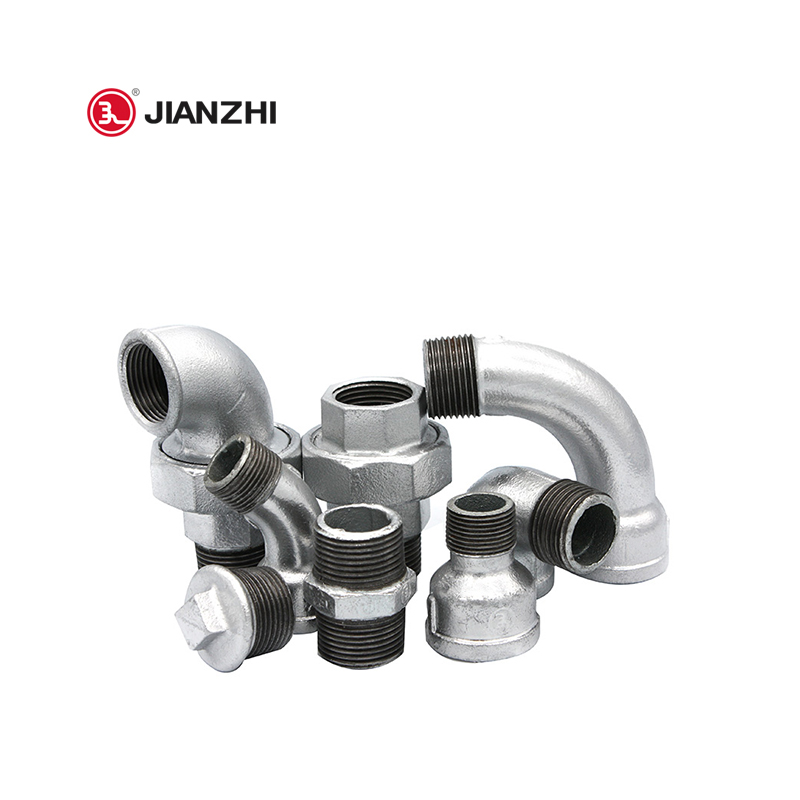Mar. 31, 2025
Galvanized pipe fittings and stainless steel pipe fittings are both widely used in pipelines and industrial fields, but there are obvious differences in material, corrosion resistance, strength and cost. Which material is more suitable depends on the specific application and environmental conditions.

● Material composition: Galvanized pipe fittings are usually made of cast iron and are treated with hot-dip galvanizing or cold-dip galvanizing (chemical galvanizing) to cover their surface with a layer of zinc.
● Corrosion protection: The zinc layer acts as a sacrificial protective layer to prevent the pipe fittings from rusting; even if the coating is damaged, the zinc will corrode preferentially, thereby protecting the substrate. For galvanized pipe fittings, the thickness of the zinc coating is particularly important. The international standard zinc coating thickness is not less than 70 microns, and the average zinc coating thickness of JIANZHI galvanized pipe fittings is not less than 100 microns. The zinc coating thickness of JIANZHI pipe fittings is 40% higher than the international standard thickness. However, this protective effect is limited in harsh environments (such as marine environments or exposure to highly corrosive chemicals).
● Limitations: The zinc layer is not self-repairing, and once damaged, the durability of the pipe fittings will decrease over time.
● Material composition: Stainless steel is an alloy containing at least 10%–11% chromium (usually nickel and molybdenum), which forms a self-repairing passive oxide film (chromium trioxide) on the surface, providing excellent corrosion resistance.
● Corrosion resistance: This self-repairing passive film allows stainless steel to exhibit far superior corrosion resistance than galvanized pipe fittings in harsh environments (including salt water environments), because stainless steel pipe fittings also contain chromium, which will react with oxygen to form chromium trioxide with a stable structure, which prevents oxygen and water from penetrating the passivation film, thereby isolating oxygen and water. Suitable for medical and food processing fields with extremely high durability requirements.
● Advantages: Even if the surface is scratched, the passivation film (chromium trioxide) can be re-formed to provide continuous protection.
☑ Strength: Galvanized fittings retain the strength of cast iron, but the zinc coating itself contributes less to structural strength.
☑ Durability: Suitable for many general applications; however, service life may be shorter in high-stress or highly corrosive environments.
☑ Welding Considerations: Toxic zinc oxide fumes may be released during welding, and welding may damage the protective coating, requiring post-weld re-galvanizing to restore protection.
☑ Strength: Stainless steel is generally stronger than galvanized fittings of the same thickness, with tensile strengths ranging from 515 to 1300 MPa, depending on the alloy.
☑ Durability: Excellent long-term performance and superior corrosion resistance for demanding, critical applications.
☑ Welding Considerations: Special techniques are required to prevent degradation of the heat-affected zone, but when properly welded, stainless steel fittings maintain their excellent corrosion resistance.
● The material and manufacturing costs are low, and the processing is simple and traditional, but it is labor-intensive, and the labor costs account for the majority.
● Applicable to places with limited budgets and low corrosive operating environments.
● Due to the high price of raw materials and complex manufacturing processes, their cost is usually about five times higher than that of galvanized pipe fittings.
● In harsh environments with long-term use and low maintenance costs, high initial investment can be exchanged for longer service life and lower maintenance costs.
● Applicable to indoor pipes, drainage systems, and budget-constrained and moderately corrosive environments.
● Commonly used in construction, especially in places where exposure to highly corrosive substances is not frequent.
● Galvanized pipe fittings are more common in water and fire protection systems and gas systems.
● Stainless steel is the first choice when higher corrosion resistance is required (such as marine, chemical, medical or high humidity environments).
● It is also often used in fields with high requirements for appearance, such as food service and architectural decoration, because of its smooth and beautiful appearance.
● Pipeline installation in coastal areas, chemical plants and medical equipment production, these high-standard and high-demand application scenarios will use more stainless steel pipe fittings.
In summary, the choice of galvanized pipe fittings or stainless steel pipe fittings depends mainly on the project requirements:
☑ Galvanized pipe fittings are economical and practical, suitable for most conventional applications, but may not be durable enough in extreme environments.
☑ Stainless steel pipe fittings provide higher strength and corrosion resistance, and are the best choice for harsh environments and applications with high durability requirements.
☑ The final decision requires a trade-off between initial cost, expected service life and maintenance requirements. Stainless steel is usually a longer-term investment in places exposed to harsh environments or with strict hygiene requirements.
If you need more details or have other questions, please feel free to contact JIANZHI!
SAFER
PRODUCT INFO
ABOUT JIANZHI
TECH DATA
Contact Us
E-mail: sales1@jianzhi-fitting.com
Tel: +86 18698027872
Office In Tianjin:
Heping District, Tianjin, China.
Production Base 1:
Chifeng, Inner Mongolia, China.
Production Base 2:
Tangshan City, Hebei Province, China.
Production Base 3:
Schelei Street,Baicoi City,Prahova County,Romania
Service email: info.ro@jianzhi-fitting.com
Sales email: market.ro@jianzhi-fitting.com
Tel: +40(755)011 849
